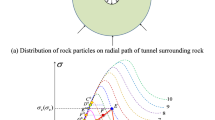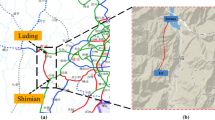Abstract
Due to the extreme complexity of mechanical response of soft surrounding rock (SR) around a tunnel under high geostatic stress conditions, the integration of physical and numerical modeling techniques was adopted. Based on the similarity theory, new composite-similar material was developed, which showed good agreement with the similarity relation and successfully simulated physico-mechanical properties (PMP) of deep buried soft rock. And the 800 mm×800 mm×200 mm physical model (PM) was conducted, in which the endoscopic camera technique was adopted to track the entire process of failure of the model all the time. The experimental results indicate that the deformation of SR around a underground cavern possessed the characteristics of development by stages and in delay, and the initial damage of SR could induce rapid failure in the later stage, and the whole process could be divided into three stages, including the localized extension of crack(the horizontal load (HL) was in the range of 130 kN to 170 kN, the vertical load (VL) was in the range of 119 kN to 153.8 kN), rapid crack coalescence (the HL was in the range of 170 kN to 210 kN, the VL was in the range of 153.8 kN to 182.5 kN) and residual strength (the HL was greater than 210 kN, the VL was greater than 182.5 kN). Under the high stress conditions, the phenomenon of deformation localization in the SR became serious and different space positions show different deformation characteristics. In order to further explore the deformation localization and progressive failure phenomenon of soft SR around the deeply buried tunnel, applying the analysis software of FLAC3D three-dimensional explicit finite-difference method, based on the composite strain-softening model of Mohr-Coulomb shear failure and tensile failure, the calculation method of large deformation was adopted. Then, the comparative analysis between the PM experiment and numerical simulation of the three centered arch tunnels was implemented and the relationship of deformation localization and progressive failure of SR around a tunnel under high stress conditions was discussed.
Similar content being viewed by others
References
LIN Peng, LIU Hong-yuan, ZHOU Wei-yuan. Experimental study on failure behavior of deep tunnels under high in-situ stresses [J]. Tunnelling and Underground Space Technology, 2015, 46: 28–45.
LI Ying-jie, ZHANG Ding-li, FANG Qian, YU Qing-chun, XIA Lu. A physical and numerical investigation of the failure mechanism of weak rocks surrounding tunnels [J]. Computers and Geotechnics, 2014, 61: 292–307.
ZHANG Z X, XU Y, KULATILAKE P H S W, HUANG X. Physical model test and numerical analysis on the behavior of stratified rock masses during underground excavation [J]. International Journal of Rock Mechanics and Mining Sciences, 2012, 49: 134–147.
LIU J, FENG X T, DING X L, ZHANG J, YUE D M. Stability assessment of the Three-Gorges Dam foundation, China, using physical and numerical modeling––Part I: physical model tests [J]. International Journal of Rock Mechanics and Mining Sciences, 2003, 40(5): 609–631.
FAIZI K, KALATEHJARI R, NAZIR R, RASHID A S A. Determination of pile failure mechanism under pullout test in loose sand [J]. Journal of Central South University, 2015, 22(4): 1490–1501.
JIANG S P, HUANG L H, SONG C J. Physical simulation analysis on construction mechanics behavior of road tunnel [J]. Chinese Journal of Rock Mechanics and Engineering, 2002, 21(5): 662–666. (in Chinese)
HE Man-chao. Physical modeling of an underground roadway excavation in geologically 45 degrees inclinedrock using infrared thermography [J]. Engineering Geology, 2011, 121(3/4): 165–176.
BRACHMAN R W I, MOORE I D, ROWE R K. The performance of a laboratory facility for evaluating the structural response of small-diamerer buried pipes [J]. Canadian Geotechnical Journal, 2001, 38(2): 260–275.
ZHU W S, ZHANG Q B, ZHU H H, LI Y, YIN J H, LI S C, SUN L F, ZHANG L. Large-scale geomechanical model testing of an underground cavern group in a true three-dimensional (3-D) stress state [J]. Canadian Geotechnical Journal, 2010, 47(9): 935–946.
BERTHOZ N, BRANQUE D, WONG H, SUBRIN D. Stress measurement in partially saturated soils and its application to physical modeling of tunnel excavation [J]. Canadian Geotechnical Journal, 2013, 50(10): 1077–1087.
GREGOR I, AKLIK P, WU W, BORJA R I. Centrifuge model test on the face stability of shallow tunnel [J]. Acta Geotechnica, 2011, 6(2): 105–117.
HU X Y, ZHANG Z X. Physical model test on the behavior of large slurry shield-driving tunnel in soft clay [J]. Journal of Shanghai Jiao Tong University: Science, 2013, 18(6): 693–698.
YANG Xiao-jie, PANG Jie-wen, LIU Dong-ming, LIU Yang, TIAN Yi-hong, MA Jiao, LI Shao-hua. Deformation mechanism of roadways in deep soft rock at Hegang Xing’an Coal Mine [J]. International Journal of Mining Science and Technology, 2013, 23(2): 307–312.
FAHIMIFAR A, GHADAMI H, AHMADVAND M. The ground response curve of underwater tunnels, excavated in a strain-softening rock mass [J]. Geomechanics and Engineering, 2015, 8(3): 323–359.
PARK K H. Similarity solution for a spherical or circular opening in elastic-strain softening rock mass [J]. International Journal of Rock Mechanics and Mining Sciences, 2014, 71: 151–159.
Itasca Consulting Group Inc. FLAC3D (Fast Lagrangian Analysis of Continnua in 3 Dimisions) User Manuals, Version 2.1 [M]. Minneapolis: Itasca Consulting Group Inc., 2002.
QIAN Qi-hu. The characteristic scientific phenomena of engineering response to deep rock mass and the implication of deepness [J]. Journal of East China Institute of Technology, 2004, 27(1): 1–5. (in Chinese)
Author information
Authors and Affiliations
Corresponding author
Additional information
Foundation item: Projects(51374257, 50804060) supported by the National Natural Science Foundation of China; Project(NCET-09-0844) supported by the New Century Excellent Talent Foundation from MOE of China
Rights and permissions
About this article
Cite this article
Zhao, Y., Zhang, Zg. Mechanical response features and failure process of soft surrounding rock around deeply buried three-centered arch tunnel. J. Cent. South Univ. 22, 4064–4073 (2015). https://doi.org/10.1007/s11771-015-2951-6
Received:
Accepted:
Published:
Issue Date:
DOI: https://doi.org/10.1007/s11771-015-2951-6




